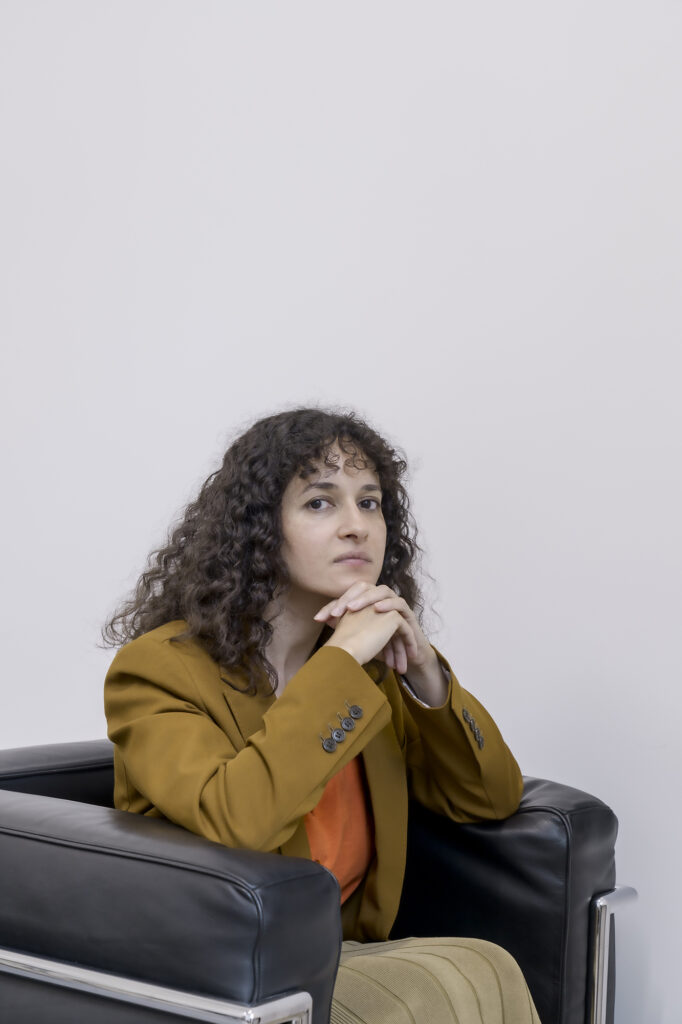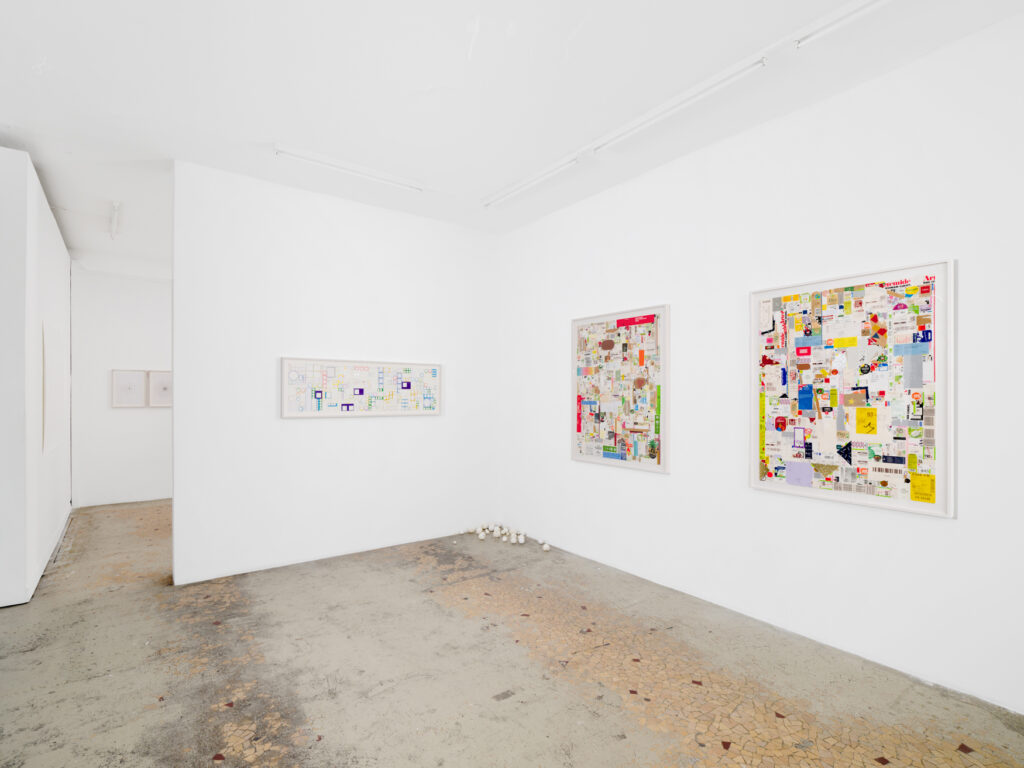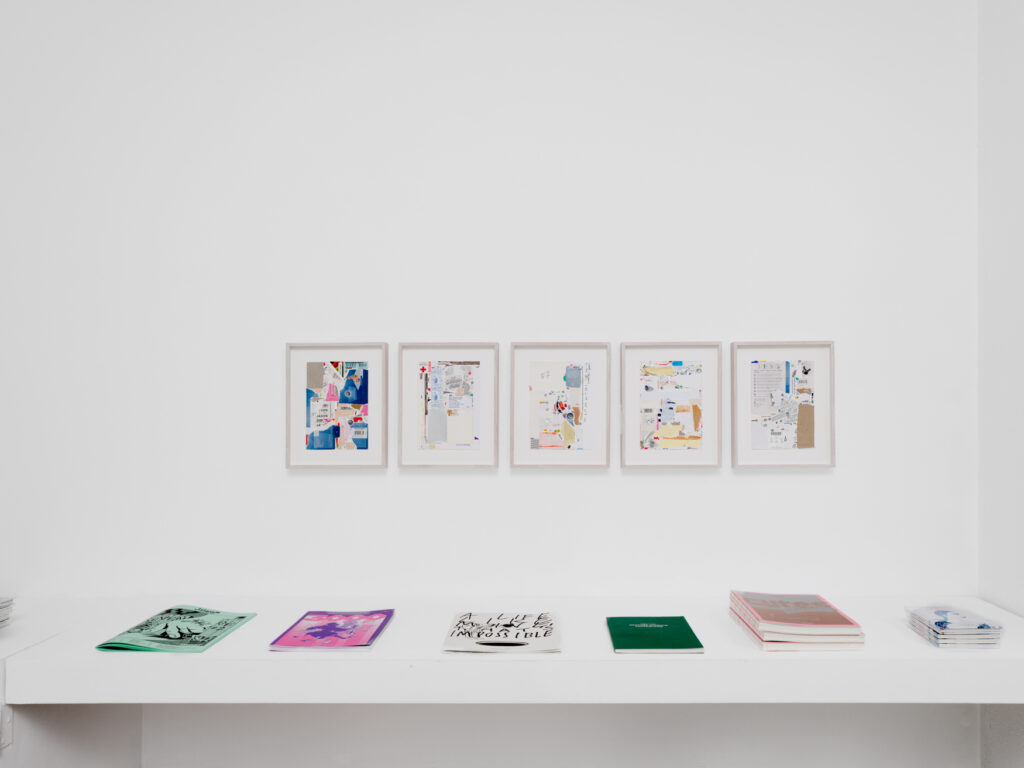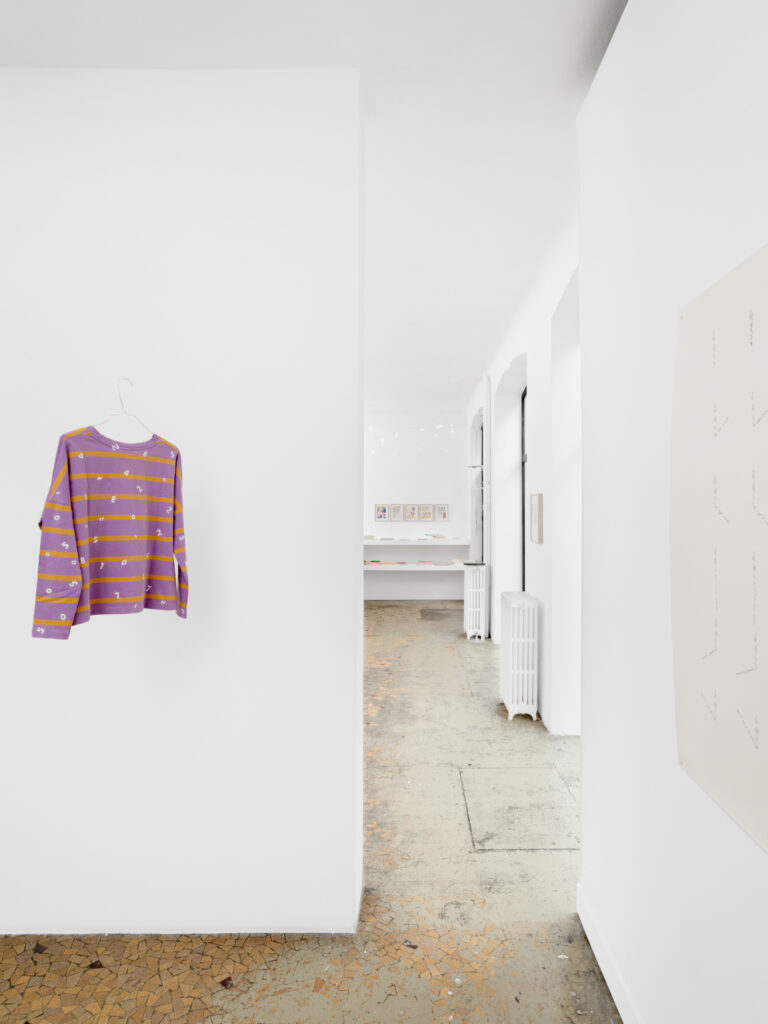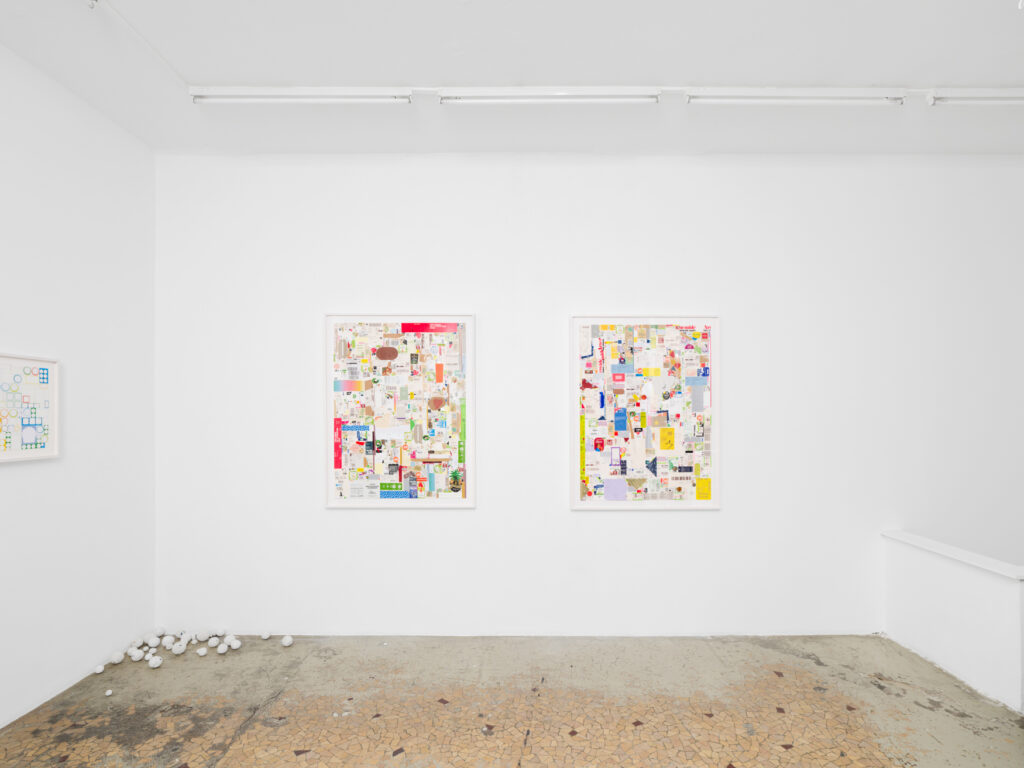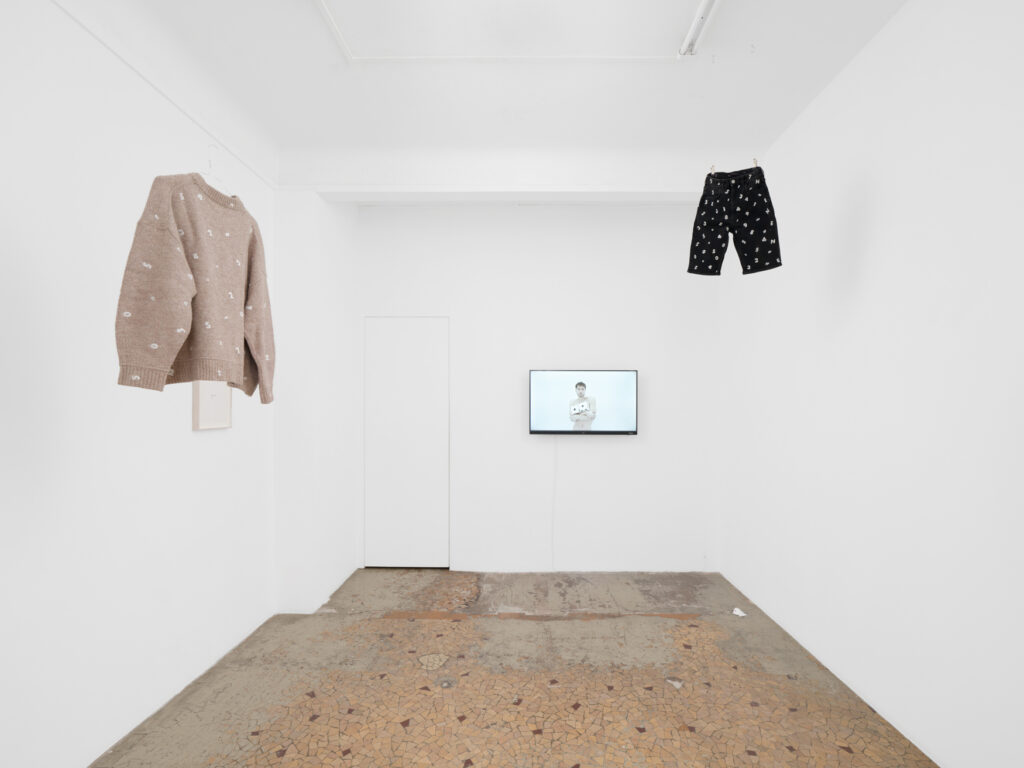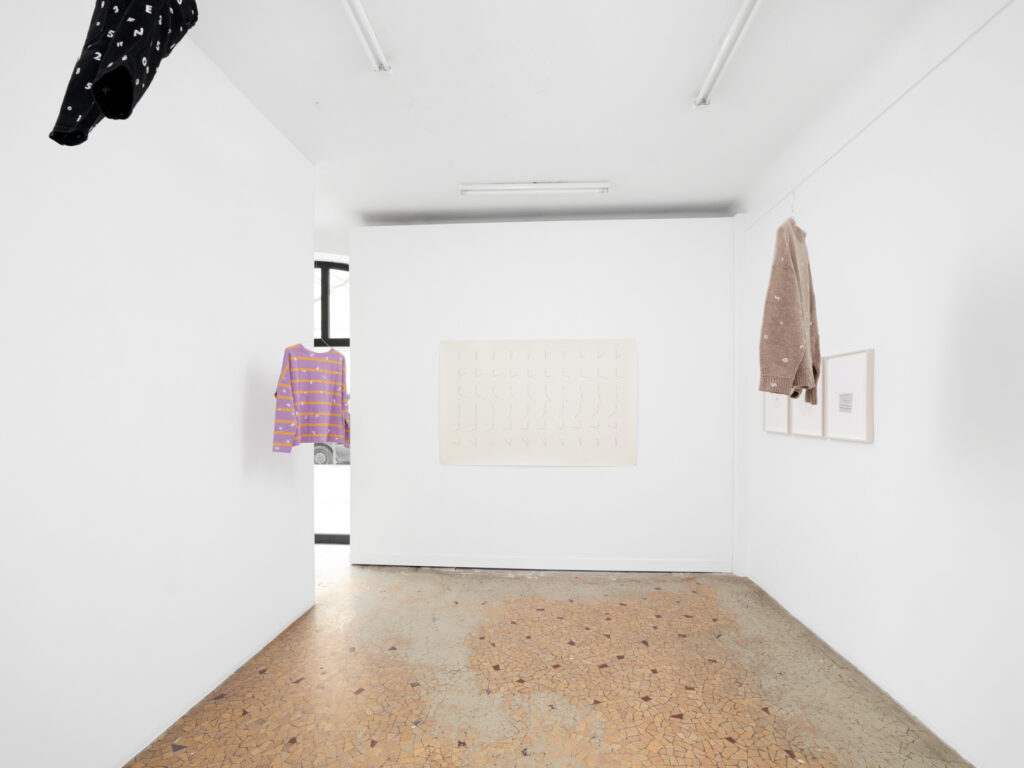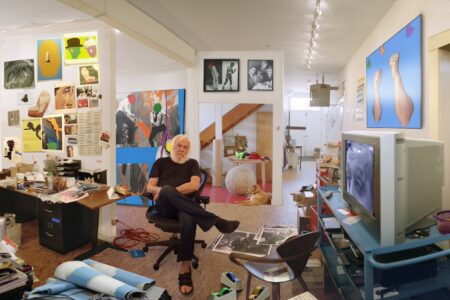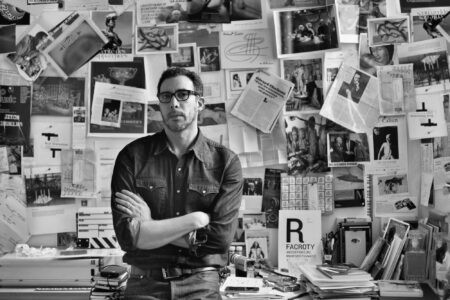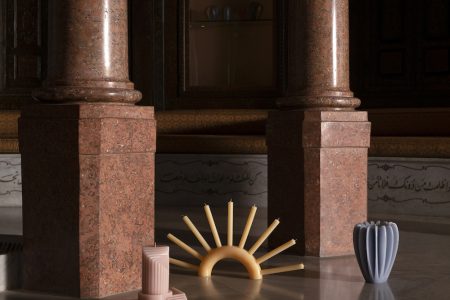
Stéphanie Saadé at Galerie Anne Barrault
TLmag spoke to contemporary artist Stéphanie Saadé about her exhibition at Galerie Anne Barrault, What makes me think about you, What makes you think about me?. This layered and poetic exhibition brings together several different aspects of her practice including collage, poetry, film, and conceptual installations. The exhibition is on view through March 8th, 2025.
TLmag: Would you talk briefly about your current exhibition at Anne Barrault, What makes me think about you, What makes you think about me?
Stéphanie Saadé: At the gallery, I am presenting a selection of recent works, many of which are being unveiled for the first time. The majority of my pieces created after 2020 have been shaped by my experience of exile in Paris, following the catastrophic Beirut Blast of August 4, 2020, and my departure from Lebanon, as well as by the profound and beautiful daily experiences that I encounter, such as motherhood. These works encapsulate a complex array of thoughts, emotions, alongside new working conditions and the incorporation of novel materials that emerged in the aftermath of that moment of rupture.
The title of the exhibition, which also exists as a calligram displayed within the gallery, carries multifaceted meanings—poetic, romantic, and decidedly political. I chose it partly because I became aware that numerous people reached out to me—thought about me—during some of Lebanon’s most tumultuous periods: the revolution, the economic collapse, the Beirut Blast, the war, while I thought of them for entirely different reasons most of the time. Often, the reciprocity and the nature of these thoughts depends on the context in which each of us finds ourselves.
As beautifully articulated by Mohammed Amer Meziane and Anissa Touati in their thoughtful text for my exhibition, translated from French to English by Edwin Nasr: “This cosmic constellation is cosmopolitical: it reminds us of what people keep forgetting and covering up. It says that what makes me think of you is not what makes you think of me—a work of dissymmetry that reminds the viewer that the privilege of oblivion is not given to those who never cease to escape destruction. Its debris doesn’t constitute a ruin. Scattered about, it persists and never ceases to enliven itself again. The insistence of elements previously thought to have been destroyed bears witness to a life that eludes all annihilative attempts. A port may explode, but the broken glass that remains claims the right to live elsewhere, transfigured by an artistic gesture that holds up a mirror to our inattentiveness, all the while affirming that no force, no state, can reduce a multitude of space-times to nothingness.”
TLmag: I was curious about your collages that use small pieces of paper, receipts, tickets – the ephemera of everyday… Is this a way to create a sense of order out of disorder… in our daily lives, but also more specifically in a country such as Lebanon, which is so often in a state of instability or uncertainty?
S.S.: Petits Papiers is an ongoing series of collages that belongs to a larger body of works on paper initiated in 2021. The title Petits Papiers derives from the eponymous song performed by the renowned French singer Régine, composed for her by Serge Gainsbourg in 1967. This evocative piece, centered around the theme of paper, begins with “Laissez parler les petits papiers” (let the little papers speak) and continues with “laissez brûler les petits papiers” (let the little papers burn). One cannot also help thinking about identity papers and the issues that can be related to them. The space that I currently live in in Paris not only serves as my home but also as my studio, blending my artistic practice with domestic life. Since I work in that domestic space, I find myself spending a considerable amount of time there. And there is matter that emerges from the mere fact of living: remnants of activities such as eating, working, writing, drawing, playing, shopping, and traveling. My artistic process often involves cultivating specific habits for a period of time. In the case of Petits Papiers, I took the habit of collecting small scraps of paper, often too small to even be worth recycling.
Starting with these tiny pieces, I began adhering them to small sheets of paper (A5 format). I later progressed to A3, and then to A0, as my collection of materials grew quickly since I developed this habit. In the end, I found each format to have its own validity and to operate differently: the smaller format creates an intimacy that invites closer inspection, while the larger format enhances the graphic impact. The process requires starting a whole series rather than isolated sheets. I begin by sticking the larger pieces, then move on to the medium-sized ones, and finally the smallest. This labor-intensive process involves a constant back and forth to accommodate each random little piece. The final step is the most time-consuming, as I wait to gather the tiniest paper fragments to fill the smallest gaps, ensuring the surface is completely saturated.
When starting, I am close to a painterly process where I compose the surface with the papers at hand. Gradually, however, the process shifts to a focus on filling in gaps, causing the composition to evolve beyond my control. The work transforms into an intricate and unlikely puzzle that I strive to complete. The eclectic elements layered on the surface engage in a buzzing visual and conceptual dialogue. The process is chronological but spans over a year or two. Many of the papers contain dates (such as expiration dates) and personal information like my name and address (from orders, for example), effectively making the work self-signed and self-dated. Through this chronology, various portraits are drawn—not only of an individual but also reflecting broader aspects of our times within a specific geography. My habit of saving papers continues while traveling, allowing the diverse graphic aesthetics of different countries, such as Lebanon, to interweave.
TLmag: In the piece Autocollants, you use discarded sticker backgrounds to create a composition that recalls a floor plan or architectural drawing, a theme which you have taken up in your Traversée des états series… are floor plans or architectural imagery something that intrigues you?
S.S.: Autocollants functions similarly to Petits Papiers in that it utilizes residue—leftover stickers that would otherwise end up in the trash. The “insignificant,” the neglected, the valueless, and what would normally be discarded are elevated to become a colorful, playful, and informative subject. However, these residues specifically arise from having a (fabulous) four-year-old daughter, who, like many children her age, loves to play with stickers. Autocollants is a work directly inspired by the experience of motherhood, much like other pieces I’ve created, for example, Pyramid. There, I collect a single type of clothing (such as T-shirts, leggings, or socks) in all available sizes and then stitch them together. Once displayed, it forms an inverted stalagmite, where its smallest layer represents the oldest one—an inverted “sedimentation” of clothing that materializes the process of growth. The stacked layers of clothing in Pyramid could echo the measured hours, minutes, and seconds in It is…, the sedimentation of time, made visible.
In Stage of Life (2022), another work made with fabric, I cut and sew the floor plan of my current Parisian apartment from a bedsheet set that belonged to my family home in Lebanon. This flat, soft fabric shelter is outlined by the boundaries of my Parisian apartment—yet another landing spot after I left Lebanon following the 2020 Beirut Blast. Sadly, the need for shelter persists, as we continue to endure times of extreme uncertainty and turmoil in my country, neighboring nations, and beyond. In Floorplan (2023), I recreate the same layout of my Paris apartment using sandpaper. Each wall of the apartment is sanded with the corresponding piece of paper, resulting in a floorplan formed from the physical remnants of the very spaces it represents.
Architectural floorplans are a form that deeply captivates me, as they allow me to trace how life unfolds within the spaces I inhabit. In Traversée des états (Crossing States), the floorplan of my family home in Lebanon—and its evolution over time—offers a lens through which I can explore broader shifts in the country’s history, architecture, and cultural touchstones, such as the music of Fairuz. In the home where I grew up, the terrazzo slabs, each measuring twenty centimeters per side and varying in patterns and colors, were arranged according to a hierarchical system I had never previously recognized. This system categorizes living spaces by importance, with each room requiring a specific type of terrazzo, ranging from the simplest to the most luxurious. For example, in the reception rooms—where inhabitants typically spend the least amount of time—the slabs feature larger marble fragments, occasionally in brighter colors, which contrast sharply with the background (a binder originally composed of lime, later cement). This terrazzo produces a striking, highly sought-after visual effect. In contrast, other spaces—such as bedrooms, kitchens, balconies, and stairwells—feature terrazzo with smaller, subtler fragments and less contrast. For years, I moved through this system unknowingly. My fascination with floorplans—and with the floor itself—stems from an interest in the least “respected” surfaces of architecture: the ones we walk on with our shoes, the lowest planes in a structure. Unlike walls or ceilings, which we strive to keep intact and immaculate, the floor is often much rougher. This overlooked surface—much like the discarded pieces of paper I mentioned earlier—becomes the very subject of my artwork.
TLmag: The use of found materials is an important part of your practice. Such as the found glass elements in the installation Free Poetry?
S.S.: Free Poetry presents a collection of traces found on dusty glass surfaces in the city of Beirut. These abandoned or neglected surfaces (cars, houses, shops) testify to the lack of care given to them, as well as to the impossibility of keeping up with the rhythm at which the city covers its objects with dust. The gestures sketched by passers-by appear to have been made in reaction to the dust that irritates and provokes, aiming to awaken or reanimate the sleeping objects. Spontaneous, ephemeral, and devoid of aesthetic concerns, the selected traces are merely silent comments, fleeting abstract inscriptions, rather than the usual salacious jokes, generic drawings, political and religious symbols, names and dates, or accidental fingerprints. Dust becomes a means of communication in the city, temporarily generating platforms that allow passers-by to express themselves in public space. These rudimentary devices paradoxically resemble contemporary tools such as mobile phones and tablets, on which fingers also leave traces. The colorless strokes have the thickness of an index, varying slightly from one individual to another. The negative drawing process partially cleans the surface, leaving an uncomfortable residue on the finger that has been in contact with the fine layers of dust. Free Poetry establishes a lasting archive of what is inherently ephemeral: fingerprints are destined to disappear at the first contact with water (rain, washing). Collected before the end of the summer of 2019, before the surfaces became clean and clear again, the traces are discreetly but permanently archived in the form of fragile glass cutouts. Initially a work about seasons, the end of summer, and the first September rain, the piece took on new meaning after the glass of the entire city of Beirut shattered following the blast, causing all these traces to disappear.
TLmag: You are interested in time and movement, the duration of time and capturing it through your Calligrams. Would you talk about this?
S.S.: My calligrams form a series of works that began with Days Spent Inside Minutes (2020), a systematic poem exploring subjective time, which I wrote at the onset of the COVID-19 pandemic. During this period, we found ourselves simultaneously facing a scarcity of space due to lockdowns, yet an abundance of time. The poem begins with “Seconds made of minutes, seconds made of hours, seconds made of days, …,” evoking the larger units of time that can be “contained” within smaller ones (for example, one minute can fit into a second). It reflects on how time, suddenly, could stretch out—returning to the notion of duration that you referenced in your question.
The term “calligrams” refers to both the eponymous poems by Guillaume Apollinaire, written during World War I, and perhaps the most iconic of all, Stéphane Mallarmé’s Un Coup de dés jamais n’abolira le hasard (1897), which also serves as the title of my new film presented at Galerie Anne Barrault. In this film, the performer, Fadi Mansour, dances with two dice at the level of his chest before ultimately casting them. The dice point to the number 1, with one dot, taking the appearance of breasts. This borrowed title connects the film to the calligrams in my exhibition. The calligrams belong to the tradition of concrete poetry: it is no longer so much about deciphering the signs as it is about contemplating them and losing oneself in them.
In my temporal calligrams, titled It is…, I developed a graphic system for writing time: hours, minutes, and seconds are fully written out, one by one. Time is written down in the way that we have learned to measure it, producing a comparative anatomy of time, of the shape of each unit of time. An anatomy of language also emerges, as the details of the shapes produced also vary according to the language used (French, Arabic or English); even when the alphabet is the same (French and English), the order of the letters generates specific forms. An even handwriting is developed in order for that anatomy to appear more clearly, a handwriting reminiscent of the one taught at school, which coincides with my child, Inge’s, and many others learning how to write. Another lesson learned at school is writing number in letters, as is the case here. This skill, seldom used in daily life, is given a chance through the temporal calligrams. A gap separates the time written and the time needed to write the time: a day, an hour or a minute take an hour to be written.
I have recently expanded It is… into an in situ interactive installation at Pakt in Amsterdam. Fatma Cheffi, who wrote the accompanying text, states: “Separated from her country, her loved ones, or her partner, and immersed in waiting, Saadé conceives a machine to count the time leading up to reunions or the end of conflict. Her machine stands apart from modern instruments of time objectification: It is… restores to time all its depth, its plasticity, and its materiality. It is… is surely part of a broader reappropriation of time, in a context marked by the return of conventional warfare and the acceleration of the world’s process of dematerialization. It is… reminds us of the power of art and poetry in reconfiguring a more human time and rhythm.”
TLmag: Tell me about inviting the comic artist Joseph Kai into your show. Have you worked with him before?
S.S.: Joseph Kai is a very talented and promising Lebanese comics author based in Paris, exploring both realistic and speculative fiction. His debut graphic novel, L’Intranquille (Casterman, 2021), also known as Restless (Street Noise Books), examines the anxious behaviors, sexual desires, and dreams of Samar, a queer artist in Lebanon during one of the most turbulent periods in the country’s history. Since 2010, Joseph is one of the collaborators and editors of Samandal, a volunteer-based non-profit organization dedicated to the advancement of the art of comics in Lebanon and the rest of the world. It Looks Like Rain, his collaboration with Nadia Christidi, is currently featured at the Sharjah Biennial. Although I had never worked with Joseph before my current show at Galerie Anne Barrault, I had seen his works and read Restless during the group exhibition Les Révolutions de l’Amour at the Institut du Monde Arabe in Paris, in which he participated. I met Joseph in person a few months before my show at the gallery, and it was an occasion for me to pick up his book from my library and read it again. In Restless, Joseph portrays situations set during Lebanon’s Civil War and more recent crises, such as the waste management crisis and the port explosion. I was struck by how, despite these episodes taking place in the past, whether recent or less so, we were experiencing the exact same situations in Lebanon and the region today: daily sonic booms (terrifying and reminiscent of explosions), shattered glass, and an overwhelming, justified sense of constant danger, of an imminent catastrophe—much like what transpired this past year. The subtlety, relevance, and recontextualization his drawings provide made me eager to showcase them. We also decided to exhibit original drawings from his book that reflect the ways in which love is found, consumed, and maybe also discarded in our time. One particularly beautiful diptych depicts a seamless transition from a phone screen—showing a man lying in bed—to a bed itself, where the same man eventually lies, before leaving.
